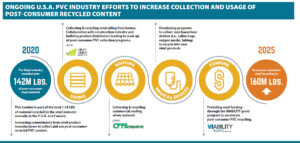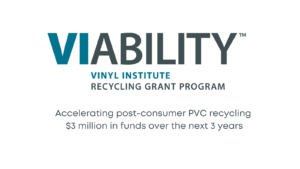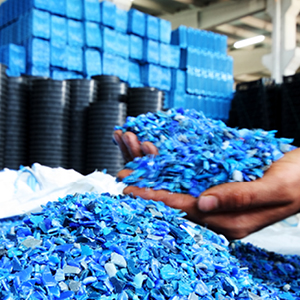The U.S. PVC Industry is Focused on Accelerating Post-Consumer PVC Recycling
The United Nations is preparing for another Intergovernmental Negotiating Committee (INC-2) meeting in Paris, France, focused on developing a global agreement that eliminates plastic pollution. The Vinyl Institute is sending a delegation to participate in the discussions.
As outlined in our support statement, the VI supports a global agreement that creates a circular economy for all plastics and eliminates plastic pollution.
Specifically,
- We support an ambitious agreement to eliminate plastic pollution through an implementable plan
- We support the creation of independent national plans of action
- We support flexibility in achieving circularity and oppose any lists that ban or restrict polymers and products
- We support policies that accelerate the implementation of the United Nations Sustainable Development Goals (UN SDGs) and include plastic products
Participating in INC-2 is an opportunity for the U.S. vinyl industry to provide educational information to other participating delegations about the PVC industry’s recycling efforts.
1.1 Billion Pounds of Pre- and Post-Consumer PVC is recycled annually in the U.S. and Canada.1
The U.S. vinyl industry is actively engaged in reducing plastic waste and has an ongoing program to grow post-consumer PVC recycling. More than 1 billion pounds of vinyl is recycled annually in the U.S. and Canada, which includes 958 million pounds of pre-consumer vinyl materials and 142 million post-consumer vinyl materials.2
Most of the recycled vinyl comes from industrial or pre-consumer recycling, but post-consumer recycling of vinyl products has increased significantly. Since 2014, there has been a 40-percent increase in post-consumer recycling, as  more and more vinyl products are finding their way into the recycling stream.3 Approximately 142 million pounds of consumer vinyl products are recycled annually.4 The industry has set a goal to increase post-consumer PVC recycling from 146 million lbs./year to 160 million lbs. per year by 2025. There are over 100 vinyl recyclers in the U.S. and Canada. The Vinyl Institute and the Vinyl Sustainability Council have developed a PVC recycling plan with the goal of increasing post-consumer recycled vinyl materials to 160 million pounds annually by 2025.
more and more vinyl products are finding their way into the recycling stream.3 Approximately 142 million pounds of consumer vinyl products are recycled annually.4 The industry has set a goal to increase post-consumer PVC recycling from 146 million lbs./year to 160 million lbs. per year by 2025. There are over 100 vinyl recyclers in the U.S. and Canada. The Vinyl Institute and the Vinyl Sustainability Council have developed a PVC recycling plan with the goal of increasing post-consumer recycled vinyl materials to 160 million pounds annually by 2025.
The U.S. resin producers provide seed funding to advance post-consumer recycling efforts.
In early 2023, the U.S. resin producers introduced the VIABILITY recycling grant program. It is a first-of-its-kind, industry-wide recycling grant program aimed at accelerating post-consumer PVC recycling across the country with the goal of increasing the volume to 160 million pounds annually by 2025. The VIABILITY program makes available up to  $1 million in funds each year over the next three years. Individual grants issued through VIABILITY are available to qualifying industry collaborations such as trade associations, material recovery facilities, construction and demolition waste facilities, recyclers, or colleges and universities in amounts up to $500,000. The funds may be used for the purchase of equipment, process investments, research and development, educational programs, and program management that supports long-lasting and sustainable recycling of vinyl products.
$1 million in funds each year over the next three years. Individual grants issued through VIABILITY are available to qualifying industry collaborations such as trade associations, material recovery facilities, construction and demolition waste facilities, recyclers, or colleges and universities in amounts up to $500,000. The funds may be used for the purchase of equipment, process investments, research and development, educational programs, and program management that supports long-lasting and sustainable recycling of vinyl products.
Opportunities to Grow Circular Solutions for PVC Recycling.
The industry is also engaged in opportunities to grow circular solutions for PVC recycling. The VI is engaging with stakeholders to broaden the use of post-consumer recycled (PRC) vinyl content. These efforts include helping to create consensus standards for PCR vinyl content to firmly establish what recyclers and processors have done successfully for decades. We’re also actively educating design teams about the benefits of using recycled content and design for recycling and initiating new programs to collect products, such as consumer products and automotive interiors.
More information about PVC:
Endnotes:
1-4: 2019 Tarnell Company Recyclers Survey for the Vinyl Institute (Amounts Sold) – PVC recycling estimates are from a tri-annual survey of 140 recyclers in US and Canada, last completed in 2019. Totals exclude manufacturing scrap that is internally reused by the producer


 more and more vinyl products are finding their way into the recycling stream.3 Approximately 142 million pounds of consumer vinyl products are recycled annually.4 The industry has set a goal to increase post-consumer PVC recycling from 146 million lbs./year to 160 million lbs. per year by 2025. There are over
more and more vinyl products are finding their way into the recycling stream.3 Approximately 142 million pounds of consumer vinyl products are recycled annually.4 The industry has set a goal to increase post-consumer PVC recycling from 146 million lbs./year to 160 million lbs. per year by 2025. There are over  $1 million in funds each year over the next three years. Individual grants issued through VIABILITY are available to qualifying industry collaborations such as trade associations, material recovery facilities, construction and demolition waste facilities, recyclers, or colleges and universities in amounts up to $500,000. The funds may be used for the purchase of equipment, process investments, research and development, educational programs, and program management that supports long-lasting and sustainable recycling of vinyl products.
$1 million in funds each year over the next three years. Individual grants issued through VIABILITY are available to qualifying industry collaborations such as trade associations, material recovery facilities, construction and demolition waste facilities, recyclers, or colleges and universities in amounts up to $500,000. The funds may be used for the purchase of equipment, process investments, research and development, educational programs, and program management that supports long-lasting and sustainable recycling of vinyl products.